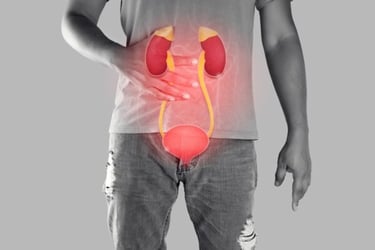Kidney Cancer


Kidney cancer is cancer that originates in the kidneys. Your kidneys are two bean-shaped organs, each about the size of your fist. They’re located behind your abdominal organs, with one kidney on each side of your spine. In adults, the most common type of kidney cancer is renal cell carcinoma. Other less common types of kidney cancer can occur, including Wilms’ tumor, which is more common in young children.
Kidney Mass Types: Cysts vs. Tumors
There are several types of kidney masses, including cysts and tumors. Kidney masses can be benign (non-cancerous) or malignant (cancerous).
Kidney cysts
Kidney cysts are fluid-filled sacs in the kidney, and they can be simple or complex. They can be given a Bosniak classification to help determine if they carry a risk of cancer. Simple cysts (Bosniak I) carry a 0% risk of cancer. Complex cysts are classified as Bosniak II, III, or IV. Bosniak II cysts carry a 15-25% risk of cancer. Bosniak III cysts carry a 50-70% risk of cancer. Bosniak IV cysts carry a 90-100% risk of cancer.


Kidney tumors
There are many types of kidney tumors. Kidney tumors can be benign (non-cancerous) or malignant (cancerous). Imaging and tests can help Dr. Gholami determine if a kidney tumor is likely benign or malignant.
Signs and Symptoms
Kidney cancer rarely causes signs or symptoms in its early stages, which is why the majority of kidney masses are detected incidentally. In the later stages, kidney cancer signs and symptoms may include:
Blood in your urine (hematuria)
Back and/or flank pain
Weight loss
Fatigue
Intermittent fever
Causes and Risk Factors
It’s not clear what causes renal cell carcinoma. Doctors know that kidney cancer begins when some kidney cells acquire mutations in their DNA. The mutations tell the cells to grow and divide rapidly. The accumulating abnormal cells form a mass that can extend beyond the kidney. Some cells can break off and spread (metastasize) to distant parts of the body.
Factors that can increase the risk of kidney cancer include:
Older age. Your risk of kidney cancer increases as you age.
Being male. Men are more likely to develop kidney cancer.
Smoking. Smokers have a greater risk of kidney cancer than nonsmokers do. The risk decreases after you quit.
Obesity. People who are obese have a higher risk of kidney cancer than do people who are considered average weight.
High blood pressure (hypertension). High blood pressure increases your risk of kidney cancer.
Chemicals in your workplace. Workers who are exposed to certain chemicals on the job may have a higher risk of kidney cancer. Some evidence suggests people who work with chemicals such as asbestos and cadmium may have an increased risk of kidney cancer.
Treatment for kidney failure. People who receive long-term dialysis to treat chronic kidney failure have a greater risk of developing kidney cancer.
Von Hippel-Lindau disease. People with this inherited disorder are likely to develop several kinds of tumors, including, in some cases, kidney cancer.
Hereditary papillary renal cell carcinoma. Having this inherited condition makes it more likely you’ll develop one or more kidney cancers.
Tests
Dr. Gholami uses the following tests for kidney masses:
Computerized tomography (CT) scan – of the abdomen and pelvis. A CT scan allows Dr. Gholami to visualize your kidney mass. This helps him to view your anatomy and make the best treatment recommendation for you.
Ultrasound – renal/bladder. Like a CT scan, an ultrasound allows Dr. Gholami to visualize your kidney mass. He may recommend this imaging for you, however, a CT scan generally provides Dr. Gholami with better information about your anatomy.
Blood and urine tests (urinalyses). Tests of your blood and your urine can give Dr. Gholami clues about what’s causing your symptoms.
Treatments
Surgery is the initial treatment for the majority of kidney masses. Dr. Gholami performs the following surgeries for kidney masses:
Removing the affected kidney (nephrectomy). Nephrectomy involves the removal of the entire kidney. The adrenal gland may also be removed. Dr. Gholami generally performs this surgery laparoscopically, using several small incisions to insert a video camera and tiny surgical tools. He generally uses the da Vinci robot to assist him with this surgery, which helps increase his precision and limit your side effects. In rare cases, he may need to perform the nephrectomy with an open operation, meaning that he will make one large incision to access your kidney.
Removing the mass from the kidney (partial nephrectomy). During this procedure, Dr. Gholami removes the mass, rather than removing the entire kidney. Dr. Gholami generally does this surgery laparoscopically, generally with the da Vinci robot, and in rare cases he will perform them with an open operation. When this surgery is possible, it’s generally preferred over radical nephrectomy since retaining as much kidney tissue as possible may reduce your risk of later complications, such as kidney disease and the need for dialysis.
Treatment to freeze cancer cells (cryosurgery). If your mass is small (usually less than 4 centimeters), Dr. Gholami may recommend this treatment option for you. During cryosurgery, Dr. Gholami uses special needles, guided by an ultrasound probe, to cool down or freeze the cancer cells.
The type of surgery Dr. Gholami recommends for you will be based on your unique mass, anatomy, and health.
Another treatment option for kidney masses is watchful waiting. With this option, Dr. Gholami will continue to monitor your mass with repeat imaging and/or other tests, and will not treat it now. He usually does not recommend this option.
Diagnosis
Once Dr. Gholami removes your mass surgically, a pathologist will analyze it. The pathologist will determine the extent, or stage, of the cancer and assign a number, called a stage, to your cancer. Before your mass is removed and analyzed by a pathologist, imaging and tests can help detect that a mass is likely malignant (cancerous).
Kidney cancer stages include:
Stage I. At this stage, the tumor can be up to 2 3/4 inches (7 centimeters) in diameter. The tumor is confined to the kidney.
Stage II. A stage II kidney cancer is larger than a stage I tumor but is still confined to the kidney.
Stage III. At this stage, the tumor extends beyond the kidney to the surrounding tissue and may also have spread to a nearby lymph node.
Stage IV. Cancer spreads outside the kidney, to multiple lymph nodes, or to distant parts of the body, such as the bones, brain, liver, or lungs.
Many patients ask why Dr. Gholami does not perform a kidney biopsy (removing a small sample of tissue) prior to surgery. Kidney biopsies are not typically done, since surgery is usually the first line of treatment, and kidney biopsy carries the risk of a “false-negative.” Kidney biopsies are typically reserved for cases that are most likely to be noncancerous or for people who can’t undergo an operation.
Follow-up
After kidney cancer treatment, Dr. Gholami will monitor you at regular intervals for cancer recurrence. He recommends the following tests: chest X-ray, CT scan of the abdomen and pelvis, and blood work with a metabolic panel.


